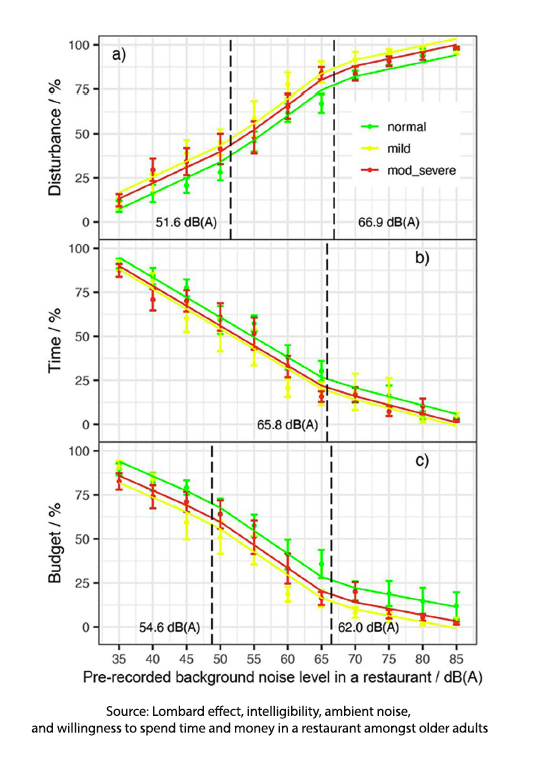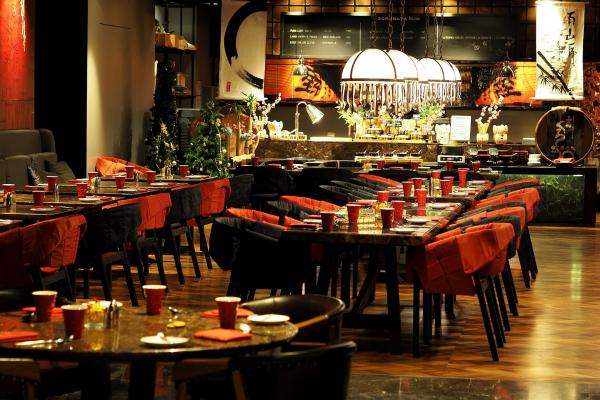Typically a restaurant’s background sounds vary from around 65 decibels (dB), everyday conversation, office chatter, to 85 dB, consistent with city traffic, nearing the range where prolonged exposure might be harmful, far less than the 95 dB of an oncoming subway train. The source of most of that noise would be us, the patrons exhibiting the Lombard Effect – “the involuntary tendency of the speaker to increase the vocal effort while speaking in loud noise.” The louder the background sound, the greater our “vocal effort” to make ourselves heard. [1]
The Oldsters
 As we age, many of us develop some degree of hearing loss; some estimates put it as high as 60%. (My wife believes mine is near 100%). The researchers sought to document the presence and reaction to the Lombard effect on adults over age 60. They recruited 31 adults over age 60 and performed a series of hearing tests to place them in one of three groups; those with normal hearing, with a mild (26-40 dB) or profound (>40 dB) hearing loss. Using headphones, they listened to ambient restaurant sounds at eleven increasingly greater decibels, from 35 dB (a whisper) to 85 dB. At the same time, they recited six sentences from a standardized text to self-assess their voice and understanding of what they were saying.
As we age, many of us develop some degree of hearing loss; some estimates put it as high as 60%. (My wife believes mine is near 100%). The researchers sought to document the presence and reaction to the Lombard effect on adults over age 60. They recruited 31 adults over age 60 and performed a series of hearing tests to place them in one of three groups; those with normal hearing, with a mild (26-40 dB) or profound (>40 dB) hearing loss. Using headphones, they listened to ambient restaurant sounds at eleven increasingly greater decibels, from 35 dB (a whisper) to 85 dB. At the same time, they recited six sentences from a standardized text to self-assess their voice and understanding of what they were saying.
For those of us in this age group, it should be no surprise that as the background decibels increased, so did “disturbances” in our perceived conversation. It also reduced the “intelligibility” of what we were hearing. As noted in the upper graphic, the effect was greater for those with mild or severe hearing loss, and there were two breakpoints at which the rate of disturbance increased.
“[At] low background noise levels, participants were annoyed by it. However, once the noise was exceeding the breakpoint, participants reported that they would have left the dining facility as quickly as they had entered.”
Restaurants should be most interested in the lower two graphs, demonstrating that as the ambient decibels increased, the willingness to spend time or money in the restaurant declined. The decline in spending was even more significant, dropping from a small 4% decline to a rather substantial 25% reduction in what the participant would have spent for a meal.
The researchers point to two limitations. First, participants did not have the advantage of visual communication clues, how our lips move and our facial expressions change. Perhaps in the setting of higher background noise, we gain additional intelligibility from those visual clues.
The Restaurant Experience
The second limitation is that dining out, besides being a social experience, involves the quality of food, service, restaurant décor, and ambiance. All of these come together to create the “dining experience.” You want to feel cozy and private, where you can converse with your tablemates and not hear the conversation at the next table. That is a difficult soundscape to create in New York, where tables are often very close. The spacing of tables is just part of a restaurant's “built environment” that influences the soundscape and our dining experience.
The background sounds of a restaurant are important. “Hubbub” imparts a sense of energy and camaraderie. Often, there is background music. Studies have demonstrated that music with faster rhythms “encourages guests to eat faster,” same for drinking – both of which enhance a restaurant's bottom line by increasing sales and turnover of tables. By the way, up-tempo music is often used in supermarkets, where they also improve the quantity and speed of purchases.
Restaurant’s built acoustics depend on the shape and size of the room and the use of sound-absorptive materials that reduce the transmission and reflection of sound. Spacing the tables further apart reduces sound transmission just as it does for viral transmission. But spacing the tables reduces revenue. Many “modern” restaurants feature open kitchens that bring the sounds of the kitchen into the dining space; or hard-surfaced walls, floors, and ceilings. All enhance sound transmission and reverberation. Using softer surfaces, carpets, drapes, and even upholstered banquettes rather than tables will reduce sound transmission.
Acoustics depend on various factors, including the shape and size of the room, the materials used in it, and where and how they are placed. Sound absorption materials alone do little to affect noise or reduce sound transmission.XXII Different materials reflect and absorb sound to different degrees.
As with so many things, creating the best restaurant soundscape is a tradeoff; between the hubbub necessary to impart vibrance and a warm cozy embrace and the increasing noise level contributed by diners experiencing the Lombard Effect that destroys that dining illusion.
[1] There is also a term for our perception of speech, which deteriorates along with increasing ambient sound; that is the Cocktail Party Effect.
Source: Lombard effect, intelligibility, ambient noise, and willingness to spend time and money in a restaurant amongst older adults Nature Scientific Reports DOI: 10.1038/s41598-022-10414-6




